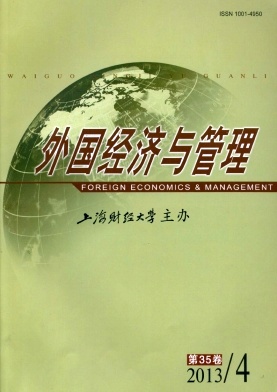人力资源管理强度研究述评与展望
外国经济与管理 2013 年 第 35 卷第 04 期, 页码:40 - 48
摘要
参考文献
摘要
"人力资源管理强度"是人力资源管理领域的重要概念,这一概念强调组织不仅要重视人力资源管理各项具体措施本身,而且要重视措施的执行及其效果。本文通过文献回顾,从人力资源管理强度概念的形成与内涵,维度与测量以及相关实证研究等方面对现有研究进行了综述,并基于现有研究的不足,提出了未来进一步研究的方向。
[1]Ashforth B E.Climate formation:Issues and extensions[J].A-cademy of Management Review,1985,10(4):837-847.
[2]Bandura A.Social foundations of thought and action:A social cognitive theory[M].Englewood Cliffs,NJ:Prentice-Hall,Inc.,1986.
[3]Bowen D E,et al.HRM and service fairness:How being fair with employees spills over to customers[J].Organizational Dynamics,1999,27(3):7-23.
[4]Bowen D E and Ostroff C.Understanding HRM-firm perfor-mance linkages:The role of the strength of the HRM system[J].Academy of Management Review,2004,29(2):203-221.
[5]Chaiken S,et al.Principles of persuasion[A].Higgins E T and Kruglanski A W(Eds.).Social psychology:Handbook of basic principles[C].New York:Guilford,1996.
[6]Chen S J,et al.The moderation effect of HR strength on the re-lationship between employee commitment and job perfor-mance[J].Social Behavior and Personality,2007,35(8):1121-1138.
[7]Currie G and Procter S.Exploring the relationship between HR and middle managers[J].Human Resource Management Journal,2001,11(3):53-69.
[8]Devellis R F.Scale development:Theory and applications[M].Newbury Park,CA:Sage Publications,2003.
[9]Delmotte,et al.Toward an assessment of perceived HRM sys-tem strength:Scale development and validation[J].Interna-tional Journal of Human Resource Management,2012,23(7):1481-1506.
[10]Endler N S and Magnusson D.Interactional psychology and personality[M].New York:Hemisphere,1976.
[11]Fiske S T and Taylor S E.Social cognition[M].New York:McGraw-Hill,1991.
[12]Folgr R and Cropanzano R.Organizational justice and human resource management[M].Beverly Hills,CA:Sage,1998.
[13]Frenkel S J,et al.Management organizational justice and emotional exhaustion among Chinese migrant workers:Evi-dence from two manufacturing organizations[J].British Jour-nal of Industrial Relations,2012,50(1):1467-8543.
[14]Gong Y,et al.High performance work system and collective OCB:A collective social exchange perspective[J].Human Re-source Management Journal,2010,20(2):119-137.
[15]Ichniowski C,et al.The effects of human resource manage-ment practices on productivity[J].American Economic Re-view,1997,87(3):291-313.
[16]Kelley H H.Attribution theory in social psychology[A].Le-vine D(Ed.).Nebraska symposium on motivation[C].Lin-coln:University of Nebraska Press,1967.
[17]Li X B.Strategic HRM as process:How HR system and or-ganizational climate strength influence Chinese employee atti-tudes[J].International Journal of Human Resource Manage-ment,2012,22(9):1825-1842.
[18]Martin-Alcazar F,et al.Human resource management as a field of research[J].British Journal of Management,2008,19(2):103-119.
[19]Miles R E and Snow C C.Fit,failure and the hall of fame:How companies succeed or fail[M].New York:Free Press,1994.
[20]Ostoff C,et al.Organizational culture and climate[A].Borma W C,et al(Eds.).Comprehensive handbook of psychology[C].New York:Wiley,2003.
[21]Pfeffer J.Competitive advantage through people:Unleashing the power of the workforce[M].Cambrige City:Harvard Bu-,
[22]Schwab D P.Construct validity in organizational behavior[A].Staw B M and Cummings L L(Eds.).Research in orga-nizational behavior[C].Greenwich,CT:JAI Press,1980:2-43.
[23]Siehl C.After the founder:An opportunity to manage culture[A].Frost P,et al(Eds.).Orga-nizational culture[C].Beverly Hills,CA:Sage,1985.
[24]Stanton P,et al.Singing the same song:Translating HRM messages across management hierarchies in Australian hospi-tals[J].International Journal of Human Resource Manage-ment,2010,21(4):567-581.
[25]Waldman D A and Bowen D E.The acceptability of360-de-gree appraisals:A customer-supplier relationship perspective[J].Human Resource Management,1998,37(2):117-130.
[26]Wright P and Boswell W.Desegregating HRM:A review and synthesis of micro and macro human resource management re-search[J].Journal of Management,2002,28(3):247-276.
[27]Yound M,et al.Human resource management,manufacturing strategy,and firm performance[J].Academy of Management Journal,1996,39(4):836-866.
[28]赵曙明.智力资本与心理资本的理论与实践应用研究[J].南京社会科学,2011,(2):22-29.
[2]Bandura A.Social foundations of thought and action:A social cognitive theory[M].Englewood Cliffs,NJ:Prentice-Hall,Inc.,1986.
[3]Bowen D E,et al.HRM and service fairness:How being fair with employees spills over to customers[J].Organizational Dynamics,1999,27(3):7-23.
[4]Bowen D E and Ostroff C.Understanding HRM-firm perfor-mance linkages:The role of the strength of the HRM system[J].Academy of Management Review,2004,29(2):203-221.
[5]Chaiken S,et al.Principles of persuasion[A].Higgins E T and Kruglanski A W(Eds.).Social psychology:Handbook of basic principles[C].New York:Guilford,1996.
[6]Chen S J,et al.The moderation effect of HR strength on the re-lationship between employee commitment and job perfor-mance[J].Social Behavior and Personality,2007,35(8):1121-1138.
[7]Currie G and Procter S.Exploring the relationship between HR and middle managers[J].Human Resource Management Journal,2001,11(3):53-69.
[8]Devellis R F.Scale development:Theory and applications[M].Newbury Park,CA:Sage Publications,2003.
[9]Delmotte,et al.Toward an assessment of perceived HRM sys-tem strength:Scale development and validation[J].Interna-tional Journal of Human Resource Management,2012,23(7):1481-1506.
[10]Endler N S and Magnusson D.Interactional psychology and personality[M].New York:Hemisphere,1976.
[11]Fiske S T and Taylor S E.Social cognition[M].New York:McGraw-Hill,1991.
[12]Folgr R and Cropanzano R.Organizational justice and human resource management[M].Beverly Hills,CA:Sage,1998.
[13]Frenkel S J,et al.Management organizational justice and emotional exhaustion among Chinese migrant workers:Evi-dence from two manufacturing organizations[J].British Jour-nal of Industrial Relations,2012,50(1):1467-8543.
[14]Gong Y,et al.High performance work system and collective OCB:A collective social exchange perspective[J].Human Re-source Management Journal,2010,20(2):119-137.
[15]Ichniowski C,et al.The effects of human resource manage-ment practices on productivity[J].American Economic Re-view,1997,87(3):291-313.
[16]Kelley H H.Attribution theory in social psychology[A].Le-vine D(Ed.).Nebraska symposium on motivation[C].Lin-coln:University of Nebraska Press,1967.
[17]Li X B.Strategic HRM as process:How HR system and or-ganizational climate strength influence Chinese employee atti-tudes[J].International Journal of Human Resource Manage-ment,2012,22(9):1825-1842.
[18]Martin-Alcazar F,et al.Human resource management as a field of research[J].British Journal of Management,2008,19(2):103-119.
[19]Miles R E and Snow C C.Fit,failure and the hall of fame:How companies succeed or fail[M].New York:Free Press,1994.
[20]Ostoff C,et al.Organizational culture and climate[A].Borma W C,et al(Eds.).Comprehensive handbook of psychology[C].New York:Wiley,2003.
[21]Pfeffer J.Competitive advantage through people:Unleashing the power of the workforce[M].Cambrige City:Harvard Bu-,
[22]Schwab D P.Construct validity in organizational behavior[A].Staw B M and Cummings L L(Eds.).Research in orga-nizational behavior[C].Greenwich,CT:JAI Press,1980:2-43.
[23]Siehl C.After the founder:An opportunity to manage culture[A].Frost P,et al(Eds.).Orga-nizational culture[C].Beverly Hills,CA:Sage,1985.
[24]Stanton P,et al.Singing the same song:Translating HRM messages across management hierarchies in Australian hospi-tals[J].International Journal of Human Resource Manage-ment,2010,21(4):567-581.
[25]Waldman D A and Bowen D E.The acceptability of360-de-gree appraisals:A customer-supplier relationship perspective[J].Human Resource Management,1998,37(2):117-130.
[26]Wright P and Boswell W.Desegregating HRM:A review and synthesis of micro and macro human resource management re-search[J].Journal of Management,2002,28(3):247-276.
[27]Yound M,et al.Human resource management,manufacturing strategy,and firm performance[J].Academy of Management Journal,1996,39(4):836-866.
[28]赵曙明.智力资本与心理资本的理论与实践应用研究[J].南京社会科学,2011,(2):22-29.
引用本文
唐贵瑶, 魏立群, 贾建锋. 人力资源管理强度研究述评与展望[J]. 外国经济与管理, 2013, 35(4): 40–48.
导出参考文献,格式为:





 8838
8838  459
459

